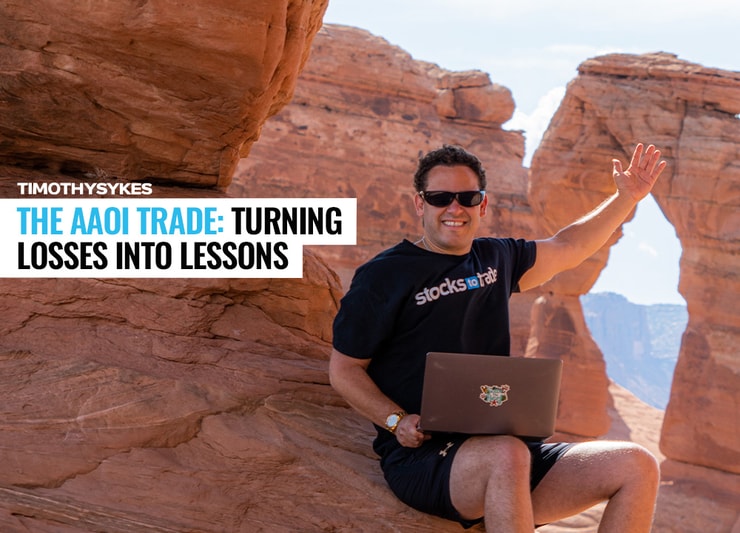Have you ever gotten into a trade that checked all the boxes?
Once you get in, it starts to misbehave…eventually forcing you to cut losses.
Moments after your exit…the stock blasts off.
But instead of profiting off the move, you’re on the sidelines, sitting on a loss.
All I can do is laugh at $AAOI as it had a terrible open & I took a loss on my https://t.co/NFpygldTfO play only to see it spike now soooooooo beautifully. Same mindfucking on #AIRevolution plays like $AI $SOUN $CXAI $GFAI $BBAI $IDAI $AITX blehhhhhhh, this sector suckssssss
— Timothy Sykes (@timothysykes) June 26, 2023
Well, it happened to me in AAOI.
But instead of letting it trigger me into making reckless decisions, I learned some valuable lessons…lessons that I believe can help you become a better trader.
Especially if you’re constantly feeding yourself with negative self-talk.
My Weekend Trade In AAOI
If you’ve been following me closely this year, you probably already know that my weekend trade has been one of my better-performing strategies.
The Cliff Notes version of the strategy is this:
- Upward trending price action heading into Friday’s close
- The stock should have a catalyst. The later on Friday, the better.
With so many traders looking to shut it down early on Friday during the summer…a lot of news flow is overlooked.
I aim to find those overlooked stocks and then sell them on Monday when more traders read up on them over the weekend.
You can learn more about the strategy in detail right here.
Anyways, AAOI has picked up a lot of momentum lately. The company announced late Wednesday that it entered into a 5-year supply agreement with Microsoft.
First off, that’s huge legitimizer news for AAOI. Anytime you can associate yourself with a powerhouse like Microsoft, it should boast well for your stock price.
Moreover, it is now being viewed as an AI play. The company is involved in optical modules and fiber optic networking…
And like Nvidia…AAOI was being looked at as a pick-and-shovel play…
Basically, you need them for AI to work. Or at least that is what traders are saying.
Shares did take off late on Wednesday in the after-hours, but then kind of died out on Thursday and Friday.
It traded in a pretty wide range…The stock hit a high of $5.67 and dipped to $3.59 by Thursday. It recaptured strength on Friday, and I saw that there was some support at $4.20ish…so I decided to take the trade for one of my weekend plays.

Here are my entry notes:
More Breaking News
- Palantir’s Resilient Performance: Could Strategic Contracts and Partnerships Propel the Stock Further?
- Is Robinhood Set to Skyrocket in 2025? Breaking Down Analyst Projections
- ChargePoint Holdings Inc. Seizes Market Momentum: Is Electric Growth Sustainable?
When Monday morning rolled around, stocks were mixed.
AAOI didn’t have that big spike I was initially anticipating.
I tried to hold on…but with the stock not moving the way I wanted it to…I bailed.
Shortly after I got out for a small loss…the stock started to rally hard past the $4.70s.
It would have been a beautiful trade. But All you can do is just laugh when something like this happens.
Unfortunately, most traders don’t.
Instead, they’ll:
- Jump into the symbol again
- Revenge trade
- Overtrade
- Put on bigger positions to make the loss up
Basically, self-destruct.
I’ve been there before and that just creates even worse feelings.
Although I would have loved to have made money on this play, I can take several positive takeaways from it.
For example:
- I stuck to my plan.
- I cut losses quickly
- I didn’t follow up by trying to do anything reckless
- I didn’t berate myself with negative self-talk
- I’m fishing in the right pond
Believe it or not, there are lessons to be learned from losses.
Instead of beating myself up, I will take all the positives from the trade.
From an execution standpoint, maybe I could have entered the trade with a smaller size since it wasn’t my ideal setup.
But that’s easy to say in hindsight.
I’ve made a few bonehead trades this year…but this wasn’t one of them.
If you’re taking Ls…you must scrutinize your trades and determine what you’re doing right and wrong.
Most importantly, you must stay positive.
If you want help in developing a structured process, this is the program I recommend.
It has helped +30 average folks on their path to becoming millionaire traders…who knows what it can do for you.




Leave a reply